Intelligent Well Completions
Bugan field gas management controls four producing zones
An integrated solution uses reservoir surveillance and smart wells.
Norbert Dolle, Shell UK Ltd, Prithipal Singh, Shell International Exploration and Production; Rob Turner, Myles Woodward, and Wan-Faisal Paino, Brunei Shell Petroleum Co.
The Bugan field was discovered in 1993 with first oil produced through the Iron Duke facilities in 2003. The field’s sandstone reservoirs were deposited in a lower shoreface environment and are faulted into twelve blocks; five blocks have been drilled.
With the Bugan-7 well, early Bugan Main block development sought to reduce uncertainties from reservoir compartmentalization, reservoir deliverability and vertical communication. Bugan-7 was completed on four stacked oil rims: M20, M30, N10 and N50. Paino et al.1 assert that the data acquired using smart well technology reduced the range of key uncertainties of the block. Continuously acquired data for downhole pressure, zonal production rates and the well’s temperature profile enabled field engineers to build a calibrated subsurface model. Based on this model, the engineers established an optimum number and location of development wells and defined a Gas Management Strategy (GMS). Due to the short production history of Bugan-7 and failure of part of the inflow control system the further development of Bugan Main still has uncertainties.
SMART FIELDS PHILOSOPHY
Shell’s Smart Fields philosophy is a holistic way of looking at production, reservoir management, and other core technical processes. It aims to maximize the life cycle value of assets by integrated development and deployment of “smart” capabilities. A smart field is one whose life cycle value is continuously optimized, Fig. 1.
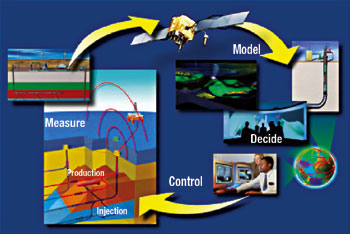 |
Fig. 1. Shell’s Smart Field philosophy includes the measure-model-decide-control loop.
|
|
Reservoir engineers use measurements (reservoir, wells, surface facilities) to update models that represent the historical, current and future performance of the field. The updated models can then be used by them to generate options for short- and long-term actions. After option evaluation, the team makes and implements a decision that optimizes life cycle value.
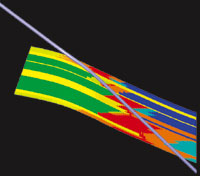 |
Fig. 2. This cross-section shows the Bugan field’s four oil rims and deviated well concept.
|
|
Concept selection for Bugan Main development focused on three well types: commingled deviated wells, along-dip horizontal wells and along-strike horizontal wells. Adding two deviated wells, in addition to Bugan-7, was the most robust development concept for a range of subsurface reasons, Fig. 2. The two proposed wells, Bugan-8 and 9, were drilled and completed in the second quarter of 2005 on the four stacked oil rims. The wells were drilled at a large stepout from the platform and it is not possible to perform downhole operations on them using wireline.
GAS MANAGEMENT STRATEGY
In a thin oil rim setting with relatively weak aquifers, as in Bugan Main, gas production needs to be limited to maximize ultimate recovery. In certain situations, the off-take rate can be limited to not exceed the critical drawdown (at which gas cusping will occur). In theory, such a production philosophy leads to oil production at the initial Gas-Oil Ratio (GOR) and increased ultimate recovery through pressure maintenance. The rates required to achieve this are generally lower than the economic rates.
In this case, perforation intervals per zone are limited to 30 to 250 m. The permeability in Bugan Main ranges from 20 – 500 mD. Analysis of the critical conditions that prevent gas cusping shows that the critical off-take rate is about 25 m3/d. To produce at economic rates, gas coning in Bugan Main cannot be prevented and the GMS has to focus on limiting free gas production, rather than preventing it.
The Bugan-7 well came onstream early 2003 and its initial rate was just over 1,300 m3/d with a negligible watercut and a GOR of about 120 m3/m3 (0.67 Mcf/bbl). The well is produced below its current producing limit to delay gas cusping. After 18 months, the GOR was about 500 m3/m3 (2.8 Mcf/bbl) and increased to 800-1,000 when Bugan-8 and 9 come onstream in late 2005.
Various GMS were evaluated for Bugan Main development, producing these recommendations:
- All three wells should be constrained to a maximum GOR. This GOR is maintained as long as possible by choking at surface.
- When a well cannot flow at the tubing head pressure required to maintain GOR, the GOR constraint for that particular well is increased by 500. A stepwise increment of 500 is considered practical for well surveillance and well operations.
The initial GOR constraint (plateau) determines the balance between ultimate recovery and present value of oil production, Fig. 3. The graph shows that operating at a 1,500 GOR constraint is the most economic, however it results in a 3% reduction of ultimate recovery, compared to the 500 and 1,000 GOR scenarios. The optimum initial plateau for Bugan Main development is 1,000 GOR because it enables production acceleration without a reduction in ultimate recovery, Fig. 4.
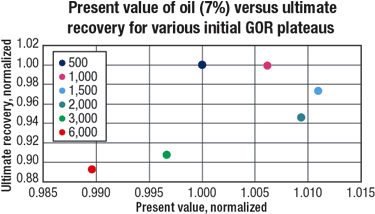 |
Fig. 3. This graph shows the balance between present value of oil and ultimate recovery for various initial GOR plateaus. Values are normalized to the initial 500 GOR plateau scenario.
|
|
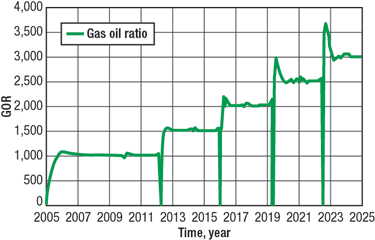 |
Fig. 4. Applying the GMS to keep the well flowing, the well’s GOR is initially constrained to 1,000 and ramped-up with stepwise increments of 500, as needed.
|
|
RESERVOIR SURVEILLANCE
Well and reservoir surveillance ensures that every oil field is operated in an effective manner to optimize recovery and/or NPV. To do this requires a thorough and continued understanding of the project’s functioning, so that deviations can be recognized, understood and corrected before they impair performance.
The Bugan Main oil rims will be developed simultaneously with production commingled from four reservoirs. Each oil rim requires surveillance to optimize zonal recovery. The GMS starting point is based on the understanding gained from the Bugan-7 well.
Continuous reservoir surveillance is required to refine and optimize the GMS, which depends on reservoir performance:
- If more reservoir energy is available than modeled in the base case (e.g. larger gas cap or stronger aquifer), then this allows for a higher initial GOR plateau, hence increased NPV, without sacrificing ultimate recovery
- If less reservoir energy is available, then tighter GOR controls are required to safeguard ultimate recovery.
Due to problems with Bugan-7’s flow control system, pressure acquisition for M20 and N10 ceased prematurely, leaving N10’s gas cap size uncertain. Simplified, scenario-based modeling evaluated the GMS with respect to N10 Gas-Initially-in-Place (GIIP) uncertainties, and Value of Information (VOI) for the actual gas cap size. Three scenarios were set for potential up- and downsides:
- Base case (100% GIIP in N10)
- Downside (50% GIIP in N10)
- Upside (200% GIIP in N10).
The limited number of pressure measurements in Bugan-7 during 2003 and the uncertainty range for N10 supported all three scenarios.
Reservoir simulations determined the optimum GMS based on initial GOR plateau, Fig. 5. The optimum GMS in the base case was previously determined at 1,000 GOR, the vertical black line. For the upside scenario, the initial GOR plateau can be increased to 2,000 without sacrificing reserves. This will result in improved economics from higher oil production rates in the first years of production. In the downside scenario, the initial GOR constraint should be tightened to 500. In this scenario, about 2% reserves loss would result, if the 1,000 GOR constraint is maintained.
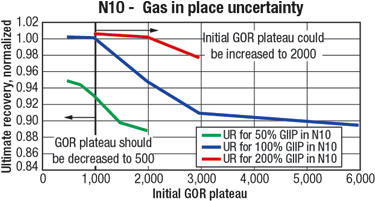 |
Fig. 5. For the upside scenario, the initial GOR plateau can be increased to 2,000 without sacrificing reserves, as shown in this graph of normalized ultimate recovery in three N10 scenarios. The vertical black line is the base case at 1,000 GOR.
|
|
These results were used to calculate a simplified VOI, Fig. 6, which enabled the GMS to be adjusted. Two VOI assumptions were made: equal probability of occurrence and “perfect” information. The latter assumption is justified, when N10 static reservoir pressures can be easily obtained, so that the gas cap size can be determined with material balance calculations.
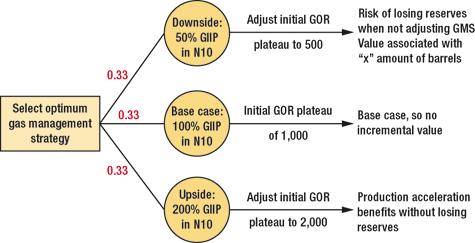 |
Fig. 6. The Value of Information approach was used to adjust the GMS assuming equal probability of occurrence and “perfect” information.
|
|
The VOI is based on safeguarding the 2% recovery in the downside scenario and the option to accelerate production without losing reserves in the upside scenario. Based on equal probabilities for each scenario, the VOI is estimated to be about $5.3 million.
The VOI is a conservative case. Its value is based on the ability to adjust the GMS to allow for N10 gas cap size uncertainties. Well and reservoir surveillance improves well and reservoir performance understanding. For future well stimulations, this can lead to closing excessive water producing zone(s), or proactively increasing the GOR when the well is approaching the unstable production region. The value of proper reservoir surveillance would exceed the VOI calculated above.
 |
Fig. 7. The completion design for Bugan-8 and 9 includes inflow control valves and downhole pressure gauges to control and monitor inflow from the M20, M30 and N10 reservoirs. N50 production is controlled with sliding side doors.
|
|
WELL COMPLETIONS
Using information gathered from well and reservoir surveillance, field engineers can generate and update well performance, material balance and subsurface models. From these, well and reservoir performance can be deduced and understood.
Based on these needs and Shell policies, the minimum surveillance requirements for Bugan Main were identified as:
- Pressure monitoring of individual zones
- Production testing of individual reservoirs to allocate production.
To meet the surveillance requirements, the completion has to have a straddle packer, which enables zonal information gathering. In addition, each zone needs a set of Down Hole Pressure Gauges (DHPG) to monitor annulus and tubing pressures and temperatures, Fig. 7. These allow static reservoir pressure and flowing build-up measurements for each zone without production deferment from other zones. The smart completion design in Table 1 was selected for Bugan-8 and 9.
Three Inflow Control Valves (ICV) will allow engineers to obtain individual reservoir pressures for four reservoirs by closing the respective ICV for the M20, M30 and N10 reservoirs. The N50 reservoir pressure will be obtained by closing the well at surface together with all three ICVs, then using the N10 tubing DHPG to measure the N50 reservoir pressure.
By testing the zones by difference, individual production rates can be obtained. The flowing bottomhole pressures of each zone allow the nodal well models to be calibrated. An additional ICV was not installed across N50, since the cost would have been significant. This would have required upgrading the flow control system to one with fewer control lines.
The authors investigated the feasibility of running a conventional completion that would meet the surveillance needs. Since the Bugan-8 and 9 well deviations do not allow wireline operations, zonal reservoir pressures and production rates can only be monitored by shifting conventional sliding side doors with Coiled Tubing (CT) interventions. The desired measurement frequency results in high operating costs for CT interventions.
Within one to two years of production, the smart completion is more cost-effective. Furthermore, conventional well interventions introduce risks and production deferment and measurements are not easily repeatable when data quality is poor. Running a smart completion is preferred over a conventional completion. The incremental costs of the smart completions are significantly lower than the previously estimated VOI.
| TABLE 1. Smart completion specifications |
 |
|
CONCLUSIONS
The drive mechanism for Bugan field’s Main block reservoirs is a combination of solution gas drive and gas cap drive. Conservation of reservoir energy, through controlled gas production, is crucial to maximize reserves. This is done by applying a GMS to maximize the ultimate oil recovery by controlling the reservoirs GOR.
The initial GOR plateau and ramp-up schedule depends on individual reservoir performance. VOI studies indicate that reservoir surveillance is required to capture available reservoir energy up- and downsides. This surveillance allows GMS adjustment to maximize value and safeguard reserves.
Smart completions with ICV and DHPG meet the surveillance requirements. Running a smart completion is preferred over a conventional completion because of lower life cycle costs, improved well and reservoir surveillance, lower operational risks and reduced production deferment.
Despite the additional initial expenditure for smart completions, this study showed that a smart completion allows optimization of the Bugan development lifecycle value. This article is an example of integrated development planning around Shell’s Smart Field philosophy and confirms the conclusion of Paino et al.: “...the value added by an optimized field development is far greater than the cost of an intelligent completion.” 
ACKNOWLEDGMENTS
The authors thank His Majesty’s government of Brunei Darussalam and the management of Brunei Shell Petroleum (BSP) for permission to publish this paper.
This article was prepared from SPE 96429, which was presented at the 2005 SPE Annual Technical Conference and Exhibition in Dallas, Texas, U.S.A., October 9 – 12, 2005 and is reprinted with permission.
LITERATURE CITED
1 Wan-Faisal Paino, Noorilmee H. Tengah, Myles I. Woodward, Nigel Snaith, Hadizah Salleh, Mark Browne, “Using Intelligent Well Technology to Define Reservoir Characterization and Reduce Uncertainty,” SPE 88533, 2004.
|
THE AUTHORS
|
| |
Norbert Dolle is an asset reservoir engineer for Shell in Aberdeen. He worked in Shell’s Technology Center for three years supporting the implementation of smart wells. Dolle earned a Masters Degree in Petroleum Engineering from Delft University of Technology.
|
|
|
Prithipal Singh is a production technologist with Shell Malaysia EP and has been with Shell for four years. He earned a Bachelors Degree in Mechanical Engineering from the University of Nebraska.
|
|
|
Rob Turner is a production technologist with Brunei Shell Petroleum.
|
|
|
Myles Woodward is a senior reservoir engineer with Brunei Shell Petroleum.
|
|
| |
Wan Faisal Paino is a reservoir engineer for the Fahud field with Petroleum Development Oman. Paino has worked as a reservoir engineer for the past 14 years. He earned from The Pennsylvania State University.
|
|
|










